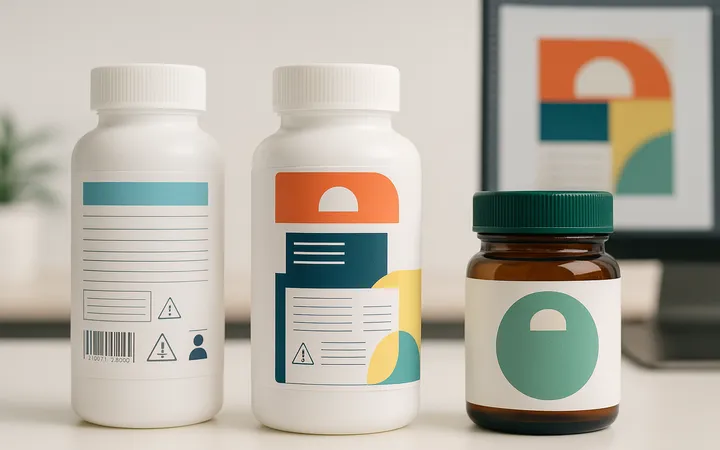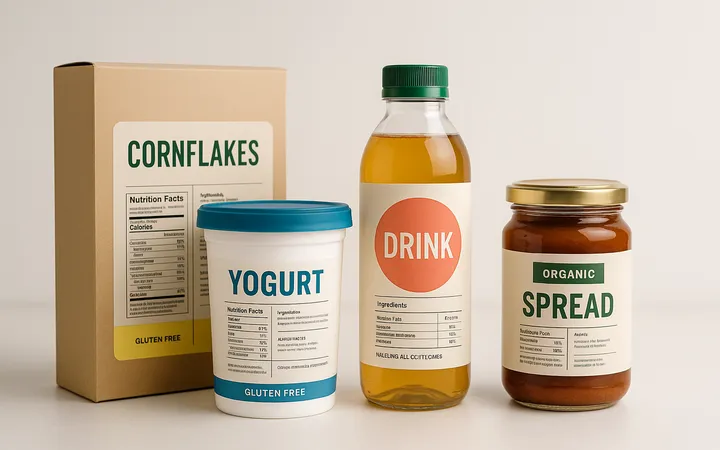
Custom Label Design for Regulatory Compliance
Key Takeaways: Essential Elements of Regulatory Compliant Labels
- Industry-specific requirements vary significantly across food, cosmetics, chemicals, pharmaceuticals, and other regulated sectors
- Material selection is crucial for ensuring durability, environmental resistance, and compatibility with specific product formulations
- Required content includes comprehensive product identification, complete ingredient listings, standardised warnings, and detailed manufacturer information
- Standardised symbols and hazard pictograms must meet precise specifications for size, colour, placement, and visibility
- Professional label design services provide expertise in balancing regulatory requirements with effective brand communication
- Multi-layer and booklet labels offer expanded space for regulatory information without sacrificing product aesthetics or brand identity
- Digital printing technologies enable cost-effective production of variable data for batch tracking and compliance verification
- Ongoing monitoring of regulatory changes ensures continued compliance in evolving regulatory environments
- International compliance considerations require understanding of diverse regional requirements and harmonisation strategies

Introduction to Regulatory Label Requirements
In today's complex regulatory environment, proper label design isn't just about aesthetics—it's about legal compliance and consumer safety. Regulatory compliance for product labels spans numerous industries, from food and cosmetics to chemicals and pharmaceuticals, with each sector governed by specific requirements and oversight agencies. The web of regulations continues to evolve, making compliance an ongoing challenge for manufacturers and distributors worldwide.
At Labelprint24, we understand that meeting these requirements can be challenging for businesses of all sizes. Regulatory compliant labels must contain specific information, use standardised symbols, maintain legibility standards, and often withstand particular environmental conditions throughout the product's entire lifecycle. Failure to meet these requirements can result in serious consequences, including costly product recalls, substantial regulatory fines, legal liability, and long-term harm to brand reputation and consumer trust.
Creating labels that both comply with regulations and effectively represent your brand requires expertise in both design principles and comprehensive regulatory knowledge. The importance of labels in regulatory compliance cannot be overstated, as they serve as the primary communication tool between manufacturers and consumers regarding product contents, usage instructions, and critical safety information. Labels are often the first line of defence in preventing misuse, ensuring proper handling, and communicating potential hazards.
Our comprehensive approach to label design services ensures that your products not only meet all applicable regulations but also maintain your brand identity and appeal to your target market. We combine technical expertise with creative design solutions to develop labels that satisfy regulatory requirements without compromising your product's visual appeal or marketing effectiveness.
Industry-Specific Regulatory Requirements
Chemical Industry Labelling Requirements
Chemical products require particularly stringent labelling to ensure safe handling, storage, and disposal. These labels must communicate hazards clearly and consistently, often following the Globally Harmonised System (GHS) for classification and labelling of chemicals. This international standard establishes specific criteria for hazard classification and standardised communication elements, including pictograms, signal words, hazard statements, and precautionary statements that must appear on labels in precise formats.
Our chemical labels are designed to withstand exposure to various substances whilst maintaining legibility throughout the product's lifecycle, even in harsh industrial environments. Key features include:

- Perfect adhesion on various substrates - Including plastic, metal, and glass containers with specialised adhesives that maintain bond strength under chemical exposure
- Chemical resistance properties - Insensitivity to acids, solvents, or alkalis to prevent degradation upon contact with the product or cleaning agents
- Superior print quality - First-class print and processing quality ensuring long-term readability of critical safety information under harsh conditions
- Comprehensive regulatory compliance - Full compliance with GHS, CLP Regulation, REACH, and industry-specific requirements across multiple jurisdictions
- Environmental durability - Resistance to UV exposure, extreme temperatures, moisture, and industrial cleaning processes
- Tamper resistance - Materials that maintain integrity and prevent unauthorised removal or alteration of safety information
Chemical labels must include specific hazard pictograms, signal words, hazard statements, precautionary statements, supplier information, and product identifiers. The design must ensure that this critical safety information remains intact and legible even in challenging industrial environments where exposure to extreme temperatures, moisture, chemicals, and physical handling is common. Our materials and adhesives are specially selected to maintain integrity under these demanding conditions, with extensive testing to verify performance in real-world applications.
Food Product Labelling Compliance
Food labelling regulations are designed to provide consumers with accurate information about ingredients, nutritional content, allergens, and safe handling instructions. These regulations vary by region but typically include requirements for ingredient lists, nutritional facts, allergen warnings, and expiration dates. In many jurisdictions, regulations also govern claims about health benefits, organic status, country of origin, and production methods.
At Labelprint24, our food labels are produced with comprehensive safety and quality measures:
- HACCP audited processes - Ensuring food safety compliance throughout production with documented quality control systems and regular auditing
- Low-migration materials - Specialised colours, varnishes, foils, and papers that prevent chemical transfer to food products according to international migration standards
- Type your text
- Premium print quality - First-class print and processing quality ensuring clarity of nutritional information, allergen warnings, and regulatory text
- Environmental adaptability - Materials suitable for various food environments including refrigeration, freezing, high moisture, and thermal processing
- Allergen compliance - Specialised design approaches for prominent allergen warnings that meet regulatory visibility requirements whilst maintaining aesthetic appeal
- Nutritional information clarity - Strategic layout designs that present complex nutritional data in regulatory-compliant formats that remain consumer-friendly
Food labels often need to withstand refrigeration, moisture, and handling whilst remaining attractive to consumers. Our design team balances these practical requirements with aesthetic considerations to create labels that both comply with regulations and enhance your product's appeal. We pay particular attention to allergen information, ensuring it is prominently displayed according to regulatory requirements whilst maintaining an appealing overall design that effectively communicates your brand values. Our expertise extends to specialised applications such as frozen food labels that maintain adhesion and legibility at extreme temperatures, and labels for high-moisture environments that resist delamination and print degradation.
Cosmetic Product Labelling Standards
Cosmetic products require labels that include ingredient lists, usage instructions, warning statements, and manufacturer information. These labels must be durable enough to withstand exposure to the product itself as well as consumer handling. Regulations establish specific criteria for ingredient disclosure, claims substantiation, and warning statements that must appear on cosmetic labels.
Our cosmetic labels are designed to meet specific industry requirements whilst enhancing product presentation. Key features include:
- Chemical resistance - Materials that withstand exposure to cosmetic formulations including oils, alcohols, and active ingredients without degrading
- Moisture resistance - Specialised coatings and materials that maintain integrity in humid bathroom environments and during product use
- Premium aesthetics - High-quality printing and finishing options that enhance product appeal whilst maintaining regulatory compliance
- INCI compliance - Proper formatting and presentation of ingredient lists using International Nomenclature of Cosmetic Ingredients standards
- Multi-language capabilities - Solutions for products sold in multiple markets with different language requirements for regulatory information
- Security features - Anti-counterfeiting measures and tamper-evident properties for high-value cosmetic products
For specialised applications such as security labels for cosmetic products, we offer tamper-evident solutions that provide reliable protection for cosmetic packaging whilst maintaining compliance with regulatory requirements for ingredient disclosure and warning statements. These security features help protect both consumers and brand integrity by preventing counterfeiting and unauthorised tampering.
For smaller cosmetic items, such as lipsticks and balms, we create labels that fit perfectly on small tubes and tins whilst maintaining all required regulatory information in a legible format. These specialised labels are designed to withstand the oils and waxes commonly found in these products whilst providing sufficient space for ingredient lists and usage instructions despite the limited surface area available.
Pharmaceutical Industry Requirements
Key pharmaceutical labelling requirements include:
- Patient safety information - Clear presentation of dosage instructions, contraindications, side effects, and warnings in formats that minimise medication errors
- Serialisation and tracking - Unique identifiers and batch information that enable complete traceability throughout the supply chain and support anti-counterfeiting efforts
- Tamper evidence - Visible indicators of package integrity that alert patients and healthcare providers to potential tampering or counterfeiting
- Child resistance compatibility - Labels that work effectively with child-resistant packaging whilst remaining accessible to elderly patients
- Multilingual requirements - Information in multiple languages where required by local regulations, often requiring innovative space management solutions
- Accessibility features - Braille text, large print options, and high-contrast designs for patients with visual impairments
Electronics and Technical Products
Electronics and technical products face unique labelling challenges including electromagnetic compatibility requirements, environmental compliance markings, and complex safety certifications. These labels must communicate technical specifications, regulatory compliance, and safety information clearly whilst withstanding the operational environments of electronic devices.
Electronics labelling considerations include:
- Regulatory markings - Certification marks, compliance symbols, and identification codes required by various international standards and regulatory bodies
- Environmental specifications - Operating temperature ranges, humidity limits, and environmental protection ratings that inform proper usage
- Safety warnings - Electrical safety information, radiation warnings, and handling precautions specific to electronic products
- Traceability information - Serial numbers, manufacturing dates, and model identifications that support warranty and recall processes
- EMC compatibility - Labels that don't interfere with electromagnetic compatibility testing and certification requirements
- Recycling information - WEEE compliance markings and disposal instructions for end-of-life product management
Essential Components of Compliant Label Design
Required Content Elements
Regulatory compliant labels must include specific content elements, though the exact requirements vary by product type and jurisdiction. Understanding these requirements and organising them effectively is crucial for creating labels that meet legal obligations whilst remaining user-friendly and visually appealing.
Common required elements include:
- Product identification - Clear statement of identity that describes what the product is, including trade names, generic names, and classification information as required
- Manufacturer information - Company name, address, and contact details including responsible person information where required by regulations
- Net quantity declaration - Quantity of contents expressed in standardised measurements with proper formatting and placement according to regulatory specifications
- Ingredient or content listings - Complete ingredient lists in descending order of predominance, using standardised nomenclature where required
- Warning statements - Hazard information appropriate to the product type, formatted according to regulatory specifications for prominence and clarity
- Usage instructions - Proper application, dosage, or preparation methods presented in clear, understandable language for the target audience
- Origin information - Country of origin for imports and manufacturing location information to satisfy customs and consumer information requirements
- Traceability codes - Batch or lot numbers, expiration dates, and manufacturing codes for traceability throughout the supply chain
- Regulatory symbols - Required certification marks, compliance symbols, and standardised pictograms that communicate regulatory status
- Storage instructions - Proper storage conditions, temperature requirements, and handling precautions to maintain product integrity
The challenge lies in incorporating all these elements whilst maintaining readability and brand identity. Our design team at Labelprint24 has extensive experience balancing these requirements with aesthetic considerations to create labels that are both compliant and visually appealing. We carefully organise information hierarchically to ensure that critical safety information is prominently displayed whilst maintaining an overall design that effectively communicates your brand values.
For products with extensive regulatory requirements, booklet labels offer an excellent solution. These multi-page labels provide ample space for detailed information whilst maintaining a clean, professional appearance on the product. Booklet labels are particularly valuable for products that require information in multiple languages or have extensive ingredient lists, usage instructions, or safety information that would otherwise overwhelm a standard label.
Visual Elements and Standardised Symbols
Regulatory compliance often requires the use of standardised symbols, colours, and warning words. These visual elements must meet specific size, placement, and appearance requirements to ensure they effectively communicate important information to consumers. The precise specifications vary by industry and jurisdiction, but compliance is mandatory and subject to regulatory scrutiny.
Common standardised elements include:
- Hazard pictograms - Chemical product symbols that must conform to GHS or regional equivalents, with specific requirements for size, colour accuracy, and border specifications
- Allergen warnings - Food product alerts that must be prominently displayed in specified formats, often requiring bold text or contrasting backgrounds
- Recycling symbols - Material identification codes and disposal instructions to facilitate proper waste management and environmental compliance
- Age restriction symbols - Clear indicators for products not suitable for children or specific age groups, often requiring specific placement and sizing
- Safety warning symbols - Universal symbols for choking hazards, flammability, and other risks that communicate dangers at a glance
- Certification marks - Third-party verification symbols indicating compliance with industry standards or quality assurance programmes
- Accessibility symbols - Universal symbols for accessibility features, Braille indicators, and other inclusive design elements
- Regulatory compliance marks - Government-required symbols indicating approval, registration, or compliance with specific regulatory frameworks
Our design team ensures that these standardised elements are incorporated correctly whilst maintaining your brand's visual identity. We stay current with regulatory changes to ensure that all symbols and visual elements meet the latest requirements. Our expertise includes precise colour matching for standardised symbols, proper sizing and placement according to regulatory specifications, and integration of these mandatory elements into your overall label design in a way that maintains visual harmony and brand consistency.
Material Selection for Regulatory Compliance
The material used for your labels plays a crucial role in regulatory compliance. Different products and environments require specific label materials to ensure durability, legibility, and compatibility with the product. Selecting the right combination of face stock, adhesive, and protective coatings is essential for maintaining compliance throughout the product's lifecycle.
For example, labels with reverse-side printing offer a dual space for information on transparent products. This innovative approach provides:
- Double information capacity - Printing on both sides of the label, effectively doubling the available space for regulatory information without increasing label size
- Cost-effective solution - More economical alternative to multilayer labels for products with extensive information requirements
- Transparent product compatibility - Ideal solution for transparent containers where information can be read through the container walls
- Creative design opportunities - Unique visual effects that maintain compliance whilst enhancing product appeal and brand differentiation
- Regulatory efficiency - Ability to separate mandatory regulatory information from marketing content whilst maintaining visual cohesion
Material selection considerations include:
- Chemical compatibility - Materials that resist degradation when exposed to product formulations, cleaning agents, or environmental chemicals
- Temperature performance - Adhesives and face stocks that maintain integrity across required temperature ranges from freezing to high heat
- Environmental resistance - UV stability, moisture resistance, and weatherability for products exposed to outdoor conditions
- Mechanical durability - Abrasion resistance and tear strength for products subject to handling, shipping, and industrial use
- Regulatory compatibility - Food-safe materials, low-migration properties, and compliance with specific industry material standards
- Application requirements - Compatibility with automated application equipment, curved surfaces, and various substrate materials
Chemical labels require materials that resist degradation when exposed to the product itself, whilst food labels may need to withstand refrigeration or freezing. Our extensive range of materials ensures that we can provide the right solution for your specific regulatory requirements. We consider factors such as temperature exposure, moisture resistance, UV stability, abrasion resistance, and chemical compatibility when recommending materials for your regulatory compliant labels. This comprehensive approach ensures that your labels remain legible and intact throughout your product's lifecycle.
Advanced Label Solutions for Complex Regulatory Requirements
Multi-Layer and Booklet Labels for Extended Information
When regulatory requirements demand more information than can fit on a standard label, multi-layer and booklet labels provide an effective solution. These specialised labels offer additional space for detailed information whilst maintaining a clean, professional appearance. They are particularly valuable for products that must comply with regulations in multiple markets, require information in multiple languages, or have extensive ingredient lists, usage instructions, or safety information.

Our multi-layer labels are particularly useful for products that:
- Multi-jurisdictional compliance - Products requiring information in multiple languages to comply with regulations in diverse markets
- Extensive content requirements - Products with lengthy ingredient lists, detailed safety instructions, or comprehensive usage guidelines that would overwhelm a standard label
- Aesthetic preservation - Products needing detailed regulatory information without compromising visual appeal or brand presentation
- Complex regulatory frameworks - Products that must comply with regulations in multiple markets with different requirements for content format and presentation
- Professional presentation - High-value products requiring sophisticated information management without cluttered appearance
- User experience optimisation - Products where information must be organised hierarchically for different user needs and regulatory requirements
These innovative label solutions allow you to meet all regulatory requirements whilst maintaining an attractive, uncluttered product appearance. The primary label maintains your brand identity and essential information, whilst additional pages provide space for comprehensive regulatory content. Our multi-layer labels are designed with user-friendly features such as easy-open tabs, resealable adhesives, and durable construction to ensure that all information remains accessible throughout the product's lifecycle.
Advanced features of our multi-layer solutions include:
- Resealable construction - Allows consumers to access information repeatedly without damaging the label or compromising adhesion
- Sequential information organisation - Logical flow of information from basic product identification to detailed regulatory content
- Durable hinge mechanisms - Reinforced fold areas that withstand repeated opening and closing without failure
- Variable data integration - Ability to include batch-specific information, expiration dates, and traceability codes across multiple layers
- Premium finishing options - High-quality materials and printing that maintain professional appearance whilst providing functional benefits
Security Features for Tamper Evidence and Authentication
For certain products, especially in the pharmaceutical and cosmetic industries, security features are an essential component of regulatory compliance. These features help prevent counterfeiting and tampering, protecting both consumers and your brand reputation. Regulatory agencies increasingly require verifiable security features to ensure product authenticity and integrity throughout the supply chain.
Our security labels incorporate various features to meet specific regulatory requirements:
- Tamper-evident materials - Advanced materials that show visible evidence of tampering attempts through irreversible colour changes, pattern disruption, or void messaging
- Holographic authentication - Sophisticated holographic elements for authentication that cannot be easily replicated by counterfeiters, including custom holographic designs
- Serialisation capabilities - Unique identifier systems that enable verification throughout the supply chain, including QR codes, DataMatrix codes, and sequential numbering
- Destructible adhesives - Specialised adhesives that prevent label removal and reapplication without visible damage, including fragmentation and residue systems
- Covert security features - Hidden authentication elements such as microtext, UV-reactive inks, and forensic markers that provide additional layers of protection
- Digital integration - Connectivity with digital verification systems that allow real-time authentication and supply chain tracking
Advanced security applications include:
- Multi-level authentication - Combination of overt, covert, and forensic security features that provide layered protection against different counterfeiting methods
- Supply chain integration - Security features that work with track-and-trace systems to provide end-to-end verification capabilities
- Consumer verification - User-friendly authentication methods that allow consumers to verify product authenticity using smartphones or simple visual inspection
- Regulatory reporting - Security systems that generate compliance reports and audit trails required by regulatory authorities
Digital Printing Solutions for Variable Data
Many regulatory requirements involve variable data, such as batch numbers, expiration dates, and serialised identifiers. Digital printing solutions enable the efficient production of labels with variable data whilst maintaining consistent quality and appearance. These technologies allow for cost-effective production of labels with the traceability information required by many regulatory frameworks.
For businesses that need to print variable data in-house, we offer thermal transfer ribbons and inkjet labels that are compatible with a wide range of printers. These products allow you to:
- Real-time compliance - Print batch numbers, expiration dates, and other variable data as needed to maintain regulatory compliance without pre-planning requirements
- Traceability systems - Maintain compliance with traceability requirements across various regulatory frameworks through automated data printing
- Market flexibility - Adjust information for different markets or regulatory environments without ordering multiple label versions or maintaining extensive inventory
- Waste reduction - Print only the labels you need when you need them, optimising inventory management and reducing waste from expired pre-printed labels
- Regulatory adaptability - Respond quickly to changes in regulatory requirements by updating variable information as needed without complete label redesign
- Cost efficiency - Reduce costs associated with minimum order quantities and inventory management for variable data labels
Our thermal transfer resin ribbons are suitable for glossy paper, PP, PE film, and PVC, making them versatile solutions for various label applications. The print quality ensures that variable regulatory information remains clear and legible throughout the product's lifecycle, even in challenging environments. Our digital printing capabilities also allow for the production of small batches of fully printed labels with variable data, providing flexibility for products with frequent formulation changes or diverse market requirements.
Digital printing advantages include:
- High-resolution output - Sharp, clear text and graphics that meet regulatory legibility requirements even for small font sizes and complex symbols
- Colour accuracy - Precise colour reproduction for standardised symbols and regulatory markings that must meet specific colour specifications
- Production flexibility - Ability to produce short runs economically, enabling rapid response to regulatory changes or market demands
- Integration capabilities - Compatibility with enterprise resource planning systems and quality management systems for automated compliance reporting
Professional Label Design Services for Regulatory Compliance
Expert Consultation and Design Process
Navigating the complex world of regulatory compliance requires expertise in both design and regulatory requirements. Our professional label design services begin with a thorough consultation to understand your specific needs and the regulations applicable to your products. This comprehensive approach ensures that all relevant requirements are identified and addressed before the design process begins.
Our comprehensive label design process follows a systematic approach:
- Initial consultation and requirement analysis - Detailed understanding of your product, target markets, and regulatory requirements with comprehensive documentation of applicable standards
- Regulatory research and compliance mapping - Thorough research into specific regulations applicable to your product category and target markets, including recent changes and pending updates
- Conceptual design development - Creative design concepts that balance regulatory compliance with brand identity and marketing objectives, including multiple design alternatives
- Stakeholder review and refinement - Collaborative review process with your team and additional regulatory considerations, incorporating feedback and regulatory updates
- Technical specification development - Final design preparation for production with detailed specifications for materials, printing processes, and quality control requirements
- Quality assurance and compliance verification - Comprehensive review to ensure all regulatory requirements are met consistently across production runs with documented verification
- Documentation and compliance records - Complete documentation of compliance elements for your regulatory records, future reference, and audit preparation
- Ongoing support and updates - Continued monitoring of regulatory changes and support for label updates as requirements evolve
This structured approach ensures that your labels not only comply with all relevant regulations but also effectively represent your brand and appeal to your target market. Our experienced design team understands the nuances of regulatory requirements across various industries and jurisdictions, allowing them to create labels that satisfy legal requirements without compromising aesthetic quality or brand communication.
Our consultation process includes:
- Regulatory landscape analysis - Comprehensive review of current and upcoming regulations affecting your product category across all target markets
- Risk assessment - Identification of potential compliance risks and development of mitigation strategies throughout the design process
- Material compatibility review - Assessment of your product formulation and packaging to ensure label material compatibility and performance
- Brand integration strategy - Development of approaches to maintain brand identity whilst meeting regulatory requirements effectively
- Production optimisation - Consideration of manufacturing processes and quality control requirements to ensure consistent compliance
Balancing Brand Identity with Regulatory Requirements
One of the greatest challenges in regulatory compliant label design is maintaining your brand identity whilst adhering to strict regulatory requirements. Our design team excels at finding creative solutions that satisfy both needs, ensuring that your products remain visually distinctive and appealing whilst meeting all applicable regulations. We believe that compliance and effective branding are not mutually exclusive but rather complementary objectives that require thoughtful integration.

Our case studies demonstrate our ability to create compliant yet distinctive labels:
- Mass customisation excellence - For mymuesli, we developed an innovative solution for mass customisation that allowed for personalised packaging whilst maintaining regulatory compliance for food products. This groundbreaking approach enabled unique customer experiences without compromising the mandatory nutritional information and allergen warnings required by food labelling regulations, demonstrating how creativity and compliance can work together
- Process optimisation success - Our work with MELLERUD focused on optimising ordering processes for their packaging line, ensuring consistent regulatory compliance across their product range whilst streamlining production efficiency. The solution maintained their distinctive brand identity whilst incorporating all required hazard pictograms and safety information for their cleaning products, proving that operational efficiency and regulatory compliance can be achieved simultaneously
By understanding both regulatory requirements and brand strategy, we create label designs that satisfy legal requirements without compromising your brand's visual identity and market appeal. Our designers are skilled at creating hierarchical information structures that give prominence to both regulatory elements and key brand messages, ensuring that neither aspect is compromised. We also leverage innovative label formats and materials to create additional space for regulatory content when needed, allowing your brand elements to remain clear and impactful.
Our brand integration strategies include:
- Visual hierarchy development - Strategic organisation of information to ensure regulatory compliance whilst maintaining brand prominence and visual appeal
- Creative space management - Innovative use of label real estate, including multi-layer solutions and creative formatting to accommodate all required information
- Colour strategy optimisation - Thoughtful use of colour to meet regulatory requirements whilst reinforcing brand identity and visual consistency
- Typography solutions - Selection and arrangement of typefaces that meet legibility requirements whilst maintaining brand character
- Symbol integration - Seamless incorporation of mandatory symbols and pictograms into overall design schemes without disrupting brand aesthetics
Quality Control and Compliance Verification
Ensuring that your labels meet all regulatory requirements involves rigorous quality control and compliance verification. Our processes include multiple checkpoints to verify that all required elements are present, accurate, and compliant with relevant regulations. This systematic approach minimises the risk of non-compliance and provides documentation of due diligence for regulatory purposes.
Our comprehensive quality control process includes:
- Regulatory expert review - Examination by specialists familiar with industry-specific requirements across various jurisdictions, ensuring comprehensive compliance assessment
- Content verification - Systematic verification of all required content elements using comprehensive compliance checklists and cross-reference matrices
- Symbol compliance checking - Detailed verification that standardised symbols meet size, colour, and appearance requirements specified by regulations
- Variable data validation - Ensuring that variable data fields are correctly positioned and formatted for clarity, accuracy, and regulatory compliance
- Material performance testing - Comprehensive testing of label materials for durability in the intended environment through accelerated aging tests and real-world simulation
- Colour verification - Precise colour measurement and verification to ensure that standardised elements meet exact colour specifications required by regulations
- Legibility assessment - Thorough evaluation to confirm that all regulatory information meets minimum size requirements and contrast specifications for readability
- Production consistency monitoring - Ongoing quality control during production to ensure that all labels meet specifications consistently across production runs
This thorough approach minimises the risk of non-compliance and the associated consequences, providing peace of mind for our clients. Our quality control processes are documented and can be provided as evidence of due diligence in meeting regulatory requirements, which can be valuable in the event of regulatory inspections or audits. We also offer guidance on maintaining compliance records for your internal quality management systems.
Additional quality assurance measures include:
- Batch documentation - Complete records of materials, processes, and quality control measures for each production batch
- Traceability systems - Full traceability of materials and production processes to support regulatory reporting and quality investigations
- Corrective action protocols - Systematic procedures for addressing any quality or compliance issues that may arise during production
- Continuous improvement - Regular review and enhancement of quality control processes based on regulatory changes and industry best practices
Staying Current with Evolving Regulations
Monitoring Regulatory Changes
Regulatory requirements for product labels are constantly evolving, with new regulations being introduced and existing ones being updated. Staying current with these changes is essential for maintaining compliance and avoiding potential legal issues. What was compliant yesterday may not meet today's standards, making ongoing vigilance a necessity for businesses in regulated industries.
At Labelprint24, we actively monitor regulatory developments across various industries and jurisdictions. This ongoing vigilance allows us to advise our clients on upcoming changes and help them prepare for new requirements before they become mandatory. Our proactive approach helps clients avoid the disruption and expense of sudden compliance issues and allows for planned transitions to new labelling requirements.
Our comprehensive approach to monitoring regulatory changes includes:
- Industry association participation - Active membership in industry associations that provide regulatory updates, interpretation guidance, and early warning of proposed changes
- Regulatory agency monitoring - Regular review of publications from relevant regulatory agencies in major markets worldwide, including proposed rules and guidance documents
- Legal expert consultation - Ongoing consultation with legal experts specialising in product labelling requirements for various industries and jurisdictions
- Conference and seminar participation - Active participation in industry conferences and seminars focused on regulatory compliance, packaging, and labelling developments
- Alert service subscriptions - Professional subscriptions to regulatory alert services that provide timely notification of proposed and finalised changes
- International partner collaboration - Collaboration with international partners to monitor regional regulatory developments and share compliance intelligence
- Technology platform monitoring - Use of advanced monitoring platforms that track regulatory changes across multiple jurisdictions and industries
This proactive approach ensures that our clients' labels remain compliant even as regulations change over time. We provide regular updates on relevant regulatory developments and offer guidance on how these changes may affect your labelling requirements. This forward-looking perspective allows for strategic planning rather than reactive compliance measures.
Our regulatory monitoring services include:
- Quarterly compliance reviews - Regular assessment of regulatory changes affecting your product categories and markets
- Impact analysis reports - Detailed analysis of how regulatory changes may affect your existing labels and packaging
- Implementation timeline planning - Strategic planning for compliance transitions with consideration of production schedules and inventory management
- Cost impact assessment - Evaluation of the financial implications of regulatory changes and recommendations for cost-effective compliance strategies
Adapting Label Designs to New Requirements
When regulatory requirements change, label designs often need to be updated to maintain compliance. Our flexible design process allows for efficient adaptation to new requirements without completely redesigning your labels. This approach minimises disruption to your packaging processes and reduces the costs associated with regulatory transitions.
Our systematic approach to adapting label designs includes:
- Modular design architecture - Maintaining modular design elements that can be updated individually without affecting the entire label design, enabling efficient targeted changes
- Future-proofing strategies - Designing with flexibility in mind to accommodate potential future changes in regulatory requirements, including space allocation for additional information
- Template development - Creating adaptable templates that allow for efficient updates across product lines when regulations change, maintaining consistency whilst enabling compliance
- Digital printing integration - Leveraging digital printing technology for cost-effective small runs during transition periods to new requirements, enabling gradual implementation
- Scalable information hierarchies - Developing adaptable information hierarchies that can accommodate additional required elements without compromising existing content
- Expandable design frameworks - Planning for potential expansion of information requirements with scalable design approaches that can grow with regulatory demands
By planning for regulatory changes from the beginning of the design process, we help our clients minimise the cost and disruption associated with updating their labels to meet new requirements. Our experience with regulatory transitions across various industries allows us to anticipate potential challenges and develop solutions that maintain compliance whilst preserving brand identity. We can also develop phased implementation plans that allow for the gradual introduction of new label designs to coincide with production schedules and inventory management.
Implementation strategies include:
- Transition planning - Detailed planning for the transition from current to new label designs, including inventory management and production scheduling
- Regulatory timeline coordination - Coordination of label changes with regulatory implementation timelines to ensure compliance without premature obsolescence
- Cost optimisation - Strategies to minimise the financial impact of label changes, including inventory management and production efficiency measures
- Quality assurance protocols - Enhanced quality control during transition periods to ensure that new requirements are met consistently
International Compliance Considerations
For businesses selling products in multiple countries, navigating different regulatory requirements adds another layer of complexity to label design. Each jurisdiction may have its own specific requirements for content, language, symbols, and format. These variations can make it challenging to create labels that comply with regulations in all target markets without requiring completely different designs for each region.
Our expertise in international label printing requirements for regulatory compliance helps businesses navigate these complex challenges. We offer comprehensive solutions that include:
- Multi-language label solutions - Advanced multi-language labels that comply with requirements in multiple markets whilst maintaining brand consistency and visual appeal
- Booklet label applications - Innovative booklet labels that provide space for comprehensive information in multiple languages without cluttering the primary label or compromising brand presentation
- Modular design systems - Flexible modular design approaches that allow for efficient adaptation to different markets with minimal changes and maximum cost efficiency
- Market-specific consultation - Expert consultation on market-specific requirements to ensure compliance in each target market before product launch, reducing time-to-market risks
- Harmonised design strategies - Strategic harmonised designs that incorporate the most stringent requirements from various markets when possible, simplifying production and inventory management
- Universal symbol utilisation - Strategic use of universal symbols and pictograms to communicate key information across language barriers whilst meeting regulatory requirements
- Regional adaptation frameworks - Systematic approaches to regional adaptation that maintain brand integrity whilst meeting diverse regulatory requirements
By addressing international compliance considerations from the outset, we help our clients expand into new markets with confidence that their product labels meet all applicable requirements. Our international expertise helps identify potential compliance issues before they become problems, allowing for proactive solutions rather than costly remediation. We can also provide guidance on prioritising market entry based on the complexity of regulatory requirements and the compatibility of your existing labels with various international standards.
International compliance services include:
- Market entry assessments - Comprehensive evaluation of regulatory requirements for new market entry, including gap analysis and compliance roadmaps
- Regulatory harmonisation analysis - Assessment of opportunities to harmonise label designs across multiple markets whilst maintaining compliance
- Cross-border logistics support - Guidance on labelling requirements for international shipping and customs clearance processes
- Cultural adaptation consulting - Consideration of cultural factors that may affect label design and consumer acceptance in different markets
Case Studies in Regulatory Compliant Label Design

Food Industry Compliance Success
The food industry presents unique challenges for label design, with strict requirements for ingredient disclosure, nutritional information, allergen warnings, and more. Our work with food industry clients demonstrates our ability to create compliant, attractive labels that enhance product appeal whilst meeting all regulatory requirements. These solutions address both mandatory elements and voluntary claims whilst maintaining brand identity and consumer appeal.
Our case study with mymuesli highlights our innovative approach to mass customisation in food packaging. We developed a groundbreaking solution that allowed for personalised packaging whilst ensuring that all regulatory requirements were consistently met across their product range. This solution balanced the creative aspects of customisation with the strict regulatory requirements for food labelling, creating a system that maintained compliance whilst enabling unique customer experiences.
Key aspects of our food industry label solutions include:
- HACCP compliance systems - Comprehensive HACCP audited processes to ensure food safety compliance throughout the production chain, with documented quality control systems and regular auditing
- Food-safe materials - Exclusive use of low-migration colours and materials suitable for food contact according to international standards, ensuring product safety and regulatory compliance
- Regulatory information presentation - Clear, compliant presentation of allergen information and nutritional facts in formats that meet regulatory requirements whilst remaining consumer-friendly
- Environmental durability - Advanced materials that withstand refrigeration, freezing, and handling without compromising legibility or adhesion performance
- Space-efficient solutions - Innovative solutions for small containers that maintain all required information in limited space whilst preserving visual appeal
- Multilingual capabilities - Strategic use of booklet labels for products with extensive ingredient lists or multilingual requirements, enabling global market access
Our expertise in food labelling regulations helps our clients navigate this complex regulatory environment whilst maintaining their brand identity and product appeal. We stay current with evolving requirements for nutritional labelling, allergen warnings, and claims substantiation to ensure that our clients' labels remain compliant even as regulations change. Our solutions address both mandatory elements and voluntary claims, ensuring that all information presented on food labels meets applicable regulatory standards.
Chemical Product Labelling Implementation
Chemical products require particularly stringent labelling to ensure safe handling, storage, and disposal. Our work with chemical industry clients demonstrates our ability to create labels that clearly communicate hazard information whilst maintaining brand identity. These labels must meet precise specifications for hazard pictograms, signal words, and safety statements whilst remaining durable in challenging environments.
Our case study with MELLERUD, a manufacturer of cleaning and maintenance products, highlights our approach to optimising ordering processes for their packaging line. This optimisation ensured consistent regulatory compliance across their diverse product range whilst improving efficiency and reducing costs. The solution we developed maintained compliance with the Globally Harmonised System (GHS) for classification and labelling of chemicals whilst streamlining their production processes.
Key aspects of our chemical industry label solutions include:
- GHS compliance integration - Precise incorporation of GHS hazard pictograms and warning statements according to exact regulatory specifications, ensuring global compliance
- Industrial durability - Advanced materials resistant to chemical exposure, UV degradation, and challenging environmental conditions throughout the product lifecycle
- Safety information hierarchy - Clear presentation of safety information and handling instructions in hierarchical formats for easy comprehension and regulatory compliance
- Multi-substrate compatibility - Durable adhesives suitable for various container materials including plastic, metal, and glass with long-term performance
- Compact design solutions - Innovative solutions for small containers that maintain all required hazard information in limited space without compromising safety communication
- International harmonisation - Multilingual approaches for products distributed in multiple markets with different language requirements whilst maintaining consistent safety messaging
Our expertise in chemical labelling regulations helps our clients protect consumers and workers whilst avoiding potential liability issues associated with inadequate hazard communication. We understand the technical requirements for chemical labels under various regulatory frameworks and industry-specific standards. Our solutions ensure that all hazard information is presented clearly and accurately whilst maintaining your brand identity across your product range.
Cosmetic Industry Regulatory Solutions
The cosmetic industry faces specific regulatory challenges, including requirements for ingredient disclosure, usage instructions, and warning statements. Our work with cosmetic industry clients demonstrates our ability to create elegant, brand-enhancing labels that meet all regulatory requirements whilst maintaining the premium aesthetic that cosmetic products demand. These solutions address both mandatory elements and marketing claims whilst ensuring compliance with regulations governing cosmetic labelling.
Our specialised solutions for the cosmetic industry include:
- Premium security solutions - Security labels for cosmetic products that provide tamper evidence and brand protection whilst meeting regulatory requirements for ingredient disclosure and safety information
- Specialised small format labels - Labels for lipsticks and balms that fit perfectly on small tubes and tins whilst maintaining all required regulatory information in highly legible formats
- INCI compliance expertise - Proper formatting and presentation of ingredient lists using International Nomenclature of Cosmetic Ingredients standards with space-efficient layouts
- Chemical resistance engineering - Advanced materials that resist degradation when exposed to cosmetic formulations including oils, alcohols, and active ingredients
- Moisture and humidity protection - Specialised coatings and materials that maintain integrity in humid bathroom environments and during product use
- Anti-counterfeiting integration - Sophisticated security features that protect high-value cosmetic products whilst maintaining aesthetic appeal and regulatory compliance
Our cosmetic industry expertise encompasses the full range of regulatory requirements whilst maintaining the sophisticated aesthetic that cosmetic consumers expect. We understand the unique challenges of cosmetic labelling, including the need to present extensive ingredient information, usage instructions, and safety warnings in limited space whilst preserving the premium brand image that drives purchase decisions.
Conclusion: Excellence in Regulatory Compliant Label Design
Regulatory compliant label design represents a sophisticated balance of legal requirements, technical specifications, and creative excellence. In an increasingly complex regulatory environment, the importance of working with experienced professionals who understand both the legal landscape and the practical challenges of label production cannot be overstated.
At Labelprint24, we have built our reputation on delivering labels that not only meet the strictest regulatory requirements but also enhance product appeal and strengthen brand identity. Our comprehensive approach combines deep regulatory knowledge, advanced materials technology, innovative design solutions, and rigorous quality control to ensure that your products succeed in the marketplace whilst maintaining full compliance with applicable regulations.
The future of regulatory compliant labelling will continue to evolve, driven by advancing technology, changing consumer expectations, and increasingly sophisticated regulatory frameworks. Our commitment to staying at the forefront of these developments ensures that our clients remain ahead of the curve, with labelling solutions that anticipate future requirements whilst meeting today's challenges.
Whether you're launching a new product, expanding into new markets, or updating existing labels to meet changing regulations, our team of experts is ready to help you navigate the complex world of regulatory compliance whilst creating labels that truly represent your brand and appeal to your customers. Contact us today to discover how our regulatory compliant label design services can support your business objectives and ensure your continued success in regulated markets.




